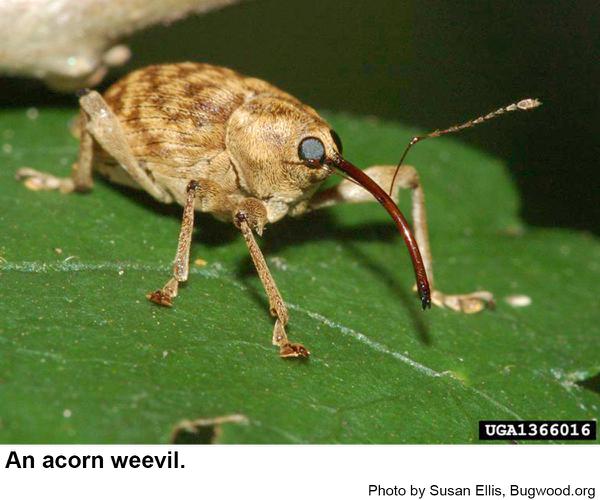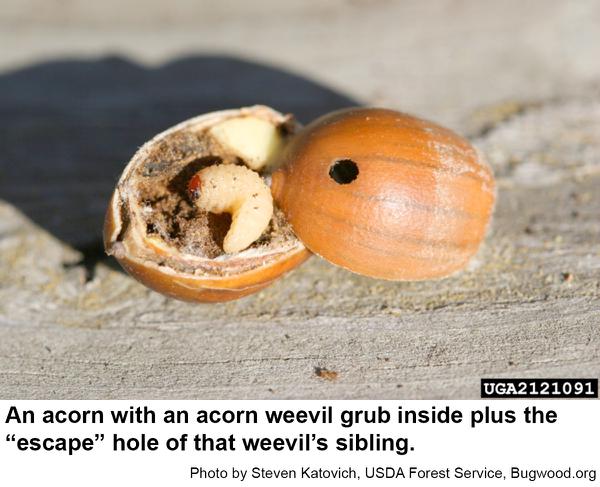Description and Biology
The acorns of various oak trees are often infested by acorn weevil grubs, Curculio glandium. These 3/8 inch-long acorn weevils have very long, slender snouts called rostrums. The rostrum of females is longer than those of males. These weevils are brown and variously patterned. Females use the chewing mouthparts at the end of their rostrums to bore holes into acorns while still on the tree during the summer. They then lay one or more eggs in the kernel of the acorn. From the eggs hatch pale grubs that are legless, short, and cylindrical with brown heads. Grubs use ridges on the underside of the body to move about. Acorn weevil grubs are curved, fatter in the middle, and grow to about 3/8 inch long. The grubs feed inside the acorn until fall when the acorns drop to the ground. Then in late fall or early winter, grubs bore circular 1/8 inch holes through which they escape. Grubs then tunnel into the soil where they remain for one to two years before pupating and emerging as a new adult weevil to repeat the wheel of existence. (One of the best places to see Curculio grubs chewing out of nuts is at the North Carolina State Fair produce display of Chinese chestnuts. Usually by the second week of the fair you can see the grubs of Curculio caryatrypes writhing around among the nuts. The grubs of the many species of Curculio are amazingly similar in appearance.)
Host Plants
Acorn weevils infest the acorns of most oak species. It is unclear whether this species also infests hickory nuts. Grubs consume the entire insides of acorns killing them completely, but they do not otherwise damage their host trees. Squirrels leave infested acorns behind so that it may appear that almost all acorns are infested.
Residential Recommendations
There is no practical way to control acorn weevils with insecticides because they emerge from the soil throughout the summer. If you are trying to collect acorns for seed, collect them just as soon as they fall and refrigerate them to slow grub development, then freeze the acorns to kill the grubs. Another method can also protect infested acorns: soak them for 20 minutes in water heated to 120° Fahrenheit (you can use higher temperatures if you are not concerned with using the acorns for seed.) Heating kills the grubs before the grubs kill the acorn. (This hot water treatment successfully kills the the very similar chestnut weevil that is a serious pest of Chinese chestnuts. African violet and hosta growers also use hot water treatment to kill broad mites and foliar nematodes without harm to the plants.)
References
- The Dark Side of Collecting Acorns. Jesse, L. No Date. News, Iowa State University Extension and Outreach.
- Growing Chinese Chestnuts in Missouri. Hunt, K. et al. 2012. University of Missouri Center for Agroforestry.
The overwintering biology of the acorn weevil, Curculio glandium in southwestern Ontario. Udaka, H., and B. J. Sinclair. 2014. Journal of Thermal Biology 44: 103–109. - NC State Extension Plant Pathology Publications
- NC State Horticultural Science Publications
- North Carolina Agricultural Chemicals Manual
For assistance with a specific problem, contact your local Cooperative Extension center.
This factsheet has not been peer reviewed.
Publication date: March 16, 2017
Reviewed/Revised: Dec. 22, 2021
N.C. Cooperative Extension prohibits discrimination and harassment regardless of age, color, disability, family and marital status, gender identity, national origin, political beliefs, race, religion, sex (including pregnancy), sexual orientation and veteran status.



